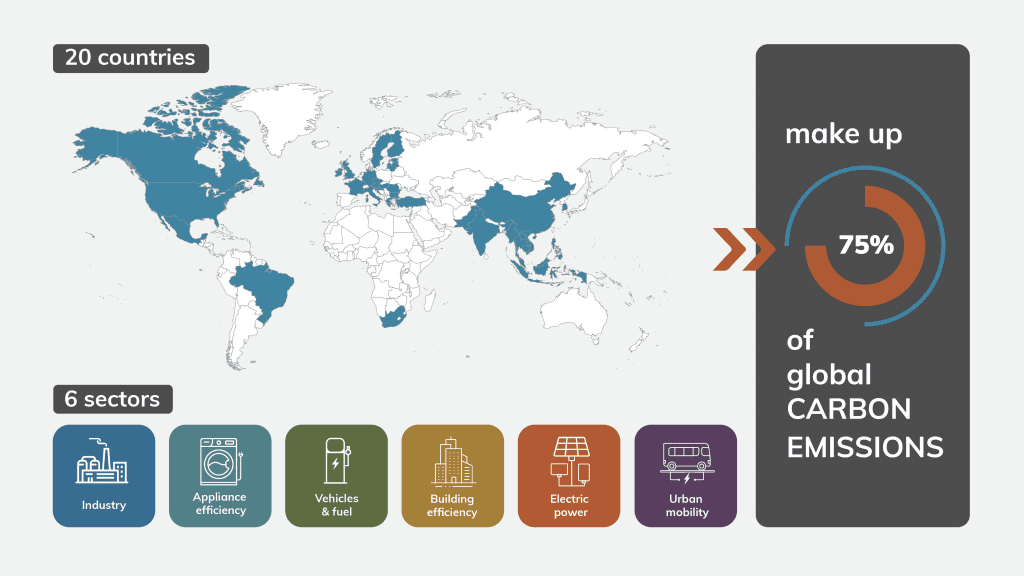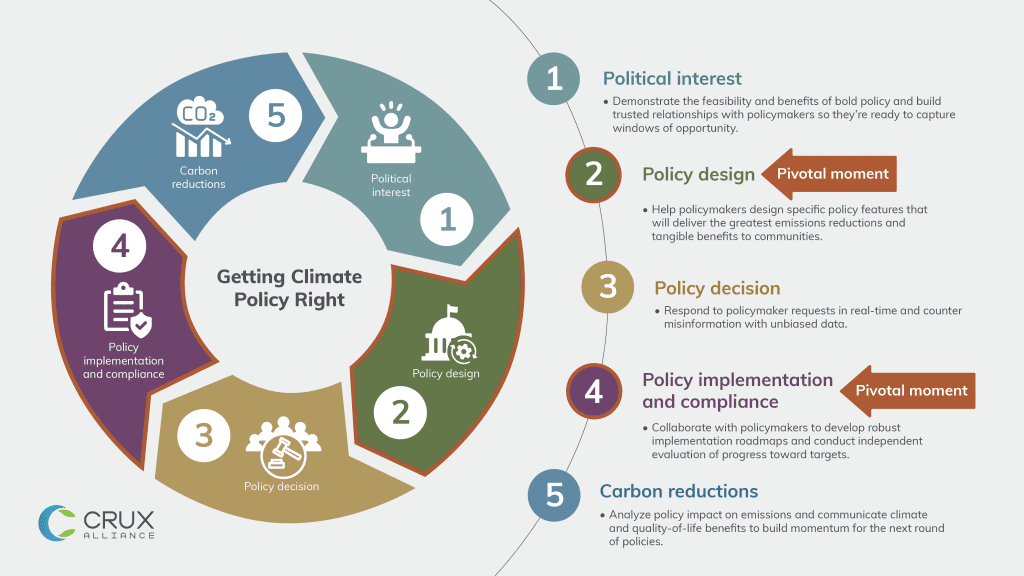The historic Paris Agreement created unprecedented political support for ambitious climate policy action. Following this milestone, a growing set of countries pledged to reduce their greenhouse gas emissions (GHG) by mid-century. In fact, 89 percent of the world’s population and 92 percent of global gross domestic product are now covered by net-zero commitments.
But how do countries move from pledges to actually cutting emissions? Designing and implementing strong climate policies is now job #1. Our success at averting dangerous climate change largely depends on how we perform over the next ten years at advancing a core set of effective low-carbon policies in the world’s major economies.
Only six sectors contribute more than 75 percent of global greenhouse gas emissions: appliances, buildings, electricity, industry, urban transportation systems, and vehicles. Furthermore, in each sector, only a handful of core policies can make the difference, putting us on track to reach our climate goals.

Get these policies right and the economy will rapidly and cost-effectively shift from fossil fuels to clean energy, cutting emissions at the speed and scale scientists say is necessary for a safe climate future. Get these policies wrong, or miss them altogether, and the world is condemned to a high-carbon future defined by dangerous climate change impacts.
The ambitious climate policy process
Policymaking is inherently challenging with many diverse interests working to influence outcomes at every stage of the process: conception, design, rulemaking, and implementation. It can be incredibly difficult for leaders to cut through the noise and make a fact-based assessment of the best policies to cost-effectively deliver the greatest possible climate, social, and economic benefits for their country.
Once a political leader commits to ambitious climate policy, they must be able to call on fast back-up from qualified experts. Policies are especially vulnerable during the regulatory or implementation phase. This pivotal moment is where the rules written to enforce a policy will determine whether it achieves its objectives.
Polluting industries set to be regulated naturally pour millions of dollars into conducting their own research and modeling that demonstrate rules could have high costs, risk economic growth, or hamper job growth – even if third-party research proves climate policy cuts costs and spurs investment.
Independent experts must serve as a counterweight, ensuring policymakers have access to the unbiased data and analysis they need to design and defend strong regulations that achieve the intended emissions reductions.
This is where the Crux Alliance comes in: A global network of non-governmental organizations with deep technical expertise and experience designing climate policies in the six highest-emitting sectors.
The Alliance is made up of six Crux Policy Centers (CPCs)—one laser-focused on each energy sector—that support local capacity for policy design and enforcement. The CPCs are independent think tanks devoted to designing and implementing ambitious climate policy. Each group has local staff, as well as local partners, in the world’s largest emitting regions.
CPCs have the expertise and credibility to support policymakers while retaining their status as independent think tanks to push for greater levels of ambition without financial conflicts of interest. The groups work with government agencies, in their country and in their language, on every element of policy from design through implementation:
Getting climate policy right
Effectively designing climate policy requires five steps:
- Political interest: First, cutting-edge research can identify the most effective climate policies and demonstrate the climate, economic, or health benefits of bold policy.
- Design: Second, technical think tanks can partner with policymakers to provide detailed assistance tailored to the unique economic, political, and social context while maintaining climate ambition.
- Decision: Third, after climate policies are proposed technical assistance efforts reach their most intense moment when the policy design details are debated. Technical expertise is most needed at this point to ensure policy integrity is maintained.
- Implementation and compliance: Fourth, technical think tanks can work with regulators to develop robust implementation plans that ensure the intention of the policy is realized.
- Carbon reductions: Fifth, as a policy takes effect technical think tanks can conduct independent assessments of the impact, make recommendations for potential future improvements, and spread best practices to other countries.

Ensuring climate policies remain strong over time
While changes in the status quo are never easy, serious technological and economic tailwinds have created new momentum for ambitious policies. Many leaders are keen to adopt cost-effective policy—but they lack ready access to global best practices, backed up by focused, timely, qualified technical support.
This missing capacity—assistance from unbiased, technical think tanks—is the gap to address in how climate policy gets made.

